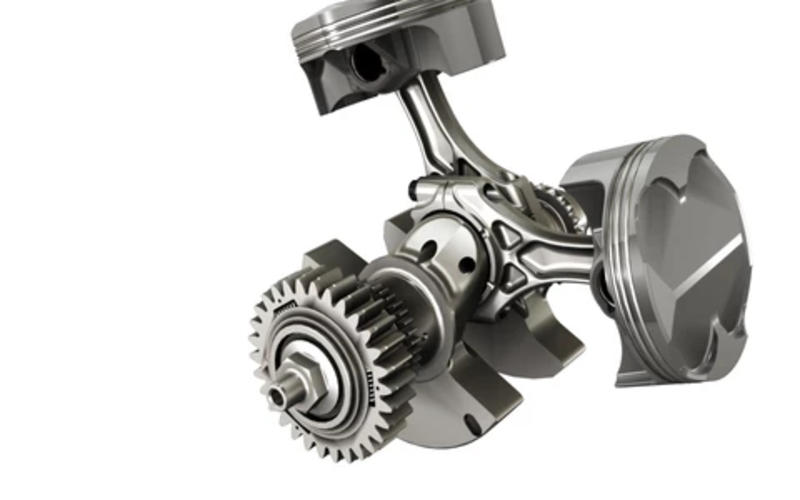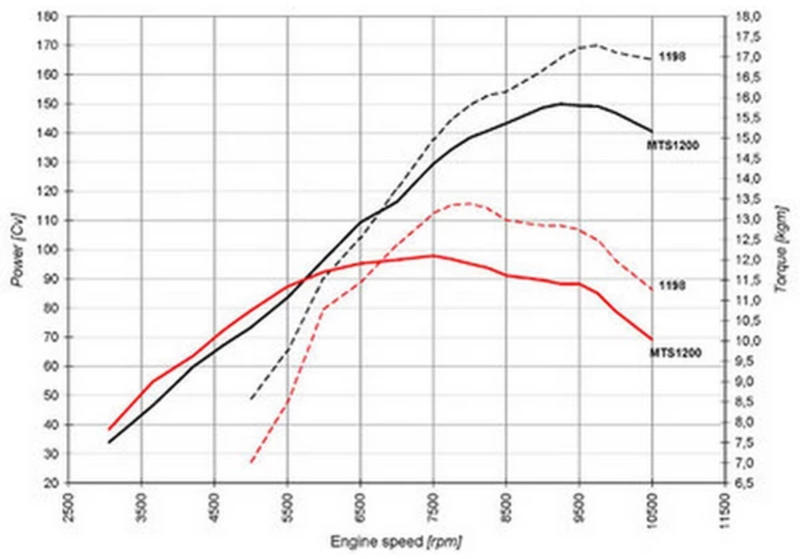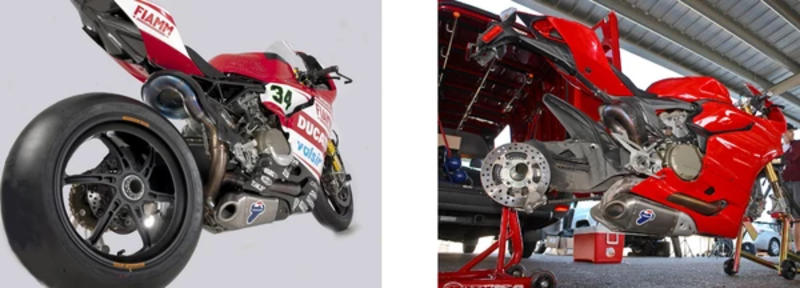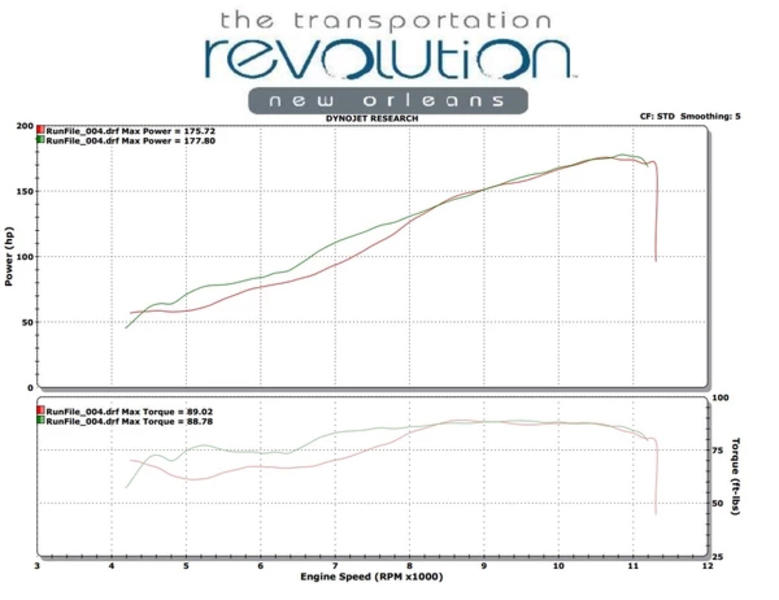The 1199’s Torque Deficit

Ducati made their name in racing using the Ltwin engine. Most of Ducati’s competition produced inline 4 cylinder machines of slightly lesser displacement. The Ltwin’s benefit is mid-range torque and grunt in corner exit while sacrificing top end horsepower to the 4 cylinder machines. The Ltwin couldn’t rev as high as the competition and the lack of valve surface area meant the 4 cylinder machines were faster on longer straights. In an effort to close the horsepower gap, Ducati has redesigned its engines continuously in the pursuit of higher revs and top end power. The culmination of this research, development and evolution is the 1199 Panigale that is capable of revving to an insane 12,000rpm in ‘R’ trim level. However, the top end power seems to come with a caveat that the engines no longer produce huge midrange torque they once did. Journalist and forum members alike are quick to point out that the oversquare nature of its engine (meaning the bore is larger than the stroke’s length) is the cause of this strange delivery of power yet, a little bit of research shows that isn’t true.
The original 851 superbike used a 92mm bore with a 64mm stroke, giving it a 1.39:1 bore/stroke ratio, oversquare, but not extreme by today’s standards. The redesigned 955cc machine utilized 96mm bore and 66mm stroke for a 1.45:1 bore/stroke ratio, all the while producing more horsepower and torque everywhere. The 996R got another bump in bore size to 98mm, stroke remained the same increasing the ratio to 1.48:1. The 999RS won the WSBK manufacturer’s championship 3 of the 5 seasons it competed. However being pushed to keep up with the now legal 1000cc 4cyl machines, Ducati used its shortest stroke ever, 58.8mm coupled with a bore of 104mm. This was the most extreme rod/stroke ratio to date of 1.77:1. Once Ducati was allowed to use 1200cc engines in WSBK, the 1098R was designed around a very oversquare 106mm bore and 67.9mm stroke (1.56:1 ratio). Each step in bore size allowed for larger diameter intake and exhaust valves to better fill and evacuate the cylinders at high rpm, a key to making horsepower. All of these models were praised for their intense torque delivery and usable power on corner exits. When the 1199 was introduced, Ducati pushed the boundaries farther with an even more radical bore/stroke ratio of 1.84:1. The bore was now a massive 112mm and stroke an incredibly short 60.7mm. While this ratio seems extreme compared to models past, if we dig deeper, it isn’t the first to use a ratio as wild as this. The same ratio was used by famous Cosworth racing V8s that had decades of great racing success in Formula 1, partially because of their very linear torque delivery making the power more accessible more of the time. How is it then, that the Superquadro engine has a reputation for a lack of midrange torque and a very peaky power delivery?

1199 and 1198 dynograph comparison
The dyno graphs don’t lie; the 1199 makes less power and torque than its predecessor until the very top of the rev range, with a very obvious dent in power from 4,000-7,000rpm. Most journalists tout the Superquadro engine as being very peaky because of it’s oversquare design implying oversquare engine design has ruined Ducati’s legendary bottom end torque. So why has the new engine lost some of that flat torque curve? In the late v-8 era of Formula1, most teams’ stroke ratios are approaching 2.5:1 and maintained flat torque curves and excellent power delivery.
The problem that no one seems to be pointing to stems from how effectively air gets into and out of the cylinders. At the most basic level, the camshaft opens, and closes the valves. To increase the efficiency at high rpm, both the intake valves and exhaust valves must remain open simultaneously for a short period. The reasoning behind this is that by opening the opening the exhaust valves the pressure in the cylinder decreases, helping to ‘pull’ the incoming charge in past the intake valves and into the cylinder; this is known as valve overlap. Ducati Superbikes have continuously increased valve overlap boost high rpm power. The trade off is the ability to fill the cylinder at low rpm, where very little to no overlap is beneficial. The road based Multistrada uses an engine called the ‘Testastretta 11 degree’ sporting a narrow-head with 11 degrees of overlap, while by comparison the engines in the 1198 and 1199 use 41 degrees of valve overlap. This helps to explain the shape of their power curves.

Multistrada and 1198 dynograph comparison
As demonstrated in the dynograph above, the 11 degree overlap of the Multistrada makes it out punch even the 1198 in torque and horsepower until 6500rpm. Past 7500rpm, the small overlap limits the Multistrada’s ability to get air into and out of the cylinders fast enough thereby torque begins to downturn where the 1198 pulls ahead.
With equal valve overlap, the 1198 trounces the 1199 in power delivery until very high engine speeds. To determine the reason we must look at other compromises made during design. The most important of which is the exhaust system diameter and its routing. In an effort to centralize mass and lower the polar moment of inertia, Ducati routed the exhaust of the Panigale so that it exits beneath the bike. This makes the bike easier to tip from side to side and overall positively effects handling characteristics. The compromise is that it doesn’t leave very much length for the exhaust piping. The exhaust pipe length is determined by many factors and specifications of the engine. Pipe diameter and length play an important part in maintaining exhaust gas velocity. The higher the exhaust gas velocity is, the easier it escapes the system and the more effectively it creates a low pressure area that helps pull the intake air into the cylinders during that huge valve overlap period. Imagine a vacuum cleaner sucking at the exhaust of the motorcycle, helping the intake air reach higher velocity than it could on its own; a very well designed system creates a similar effect. A carefully executed exhaust system takes crank angle, valve opening and closing events, rpm and several other factors into account to take advantage of exhaust pulses the engine produces to make the most horsepower and torque everywhere in the rev range.
Shown below is a photo of the exhaust system of the WSBK Ducati team compared to a road bike with the standard exhaust routing. Notice the pipe on the outside of the swingarm near the rider’s right foot on the WSBK machine? The original equipment exhaust system, and even most on the market are not designed this way.

Nicholas Udstad, a technician at TTRNO designed an exhaust system around the same principles the WSBK team used to get the most power possible out of the 1199. By choosing to have longer primary exhaust pipes than standard, along with tapered sizing as the exhaust temperature decreases, the exhaust gas velocity remains high for a longer period, escaping more quickly than the standard exhaust as well as assisting in pulling fresh intake air into the cylinder. This increase in gas velocity and faster cylinder filling is especially important at lower engine speeds where the majority of torque is produced. The obvious question to this design is ‘what are the downsides?” The main reason all the aftermarket manufacturers don’t make their exhaust systems this way is cost. It is expensive to perform the R&D necessary to find out what the best overall design will be rather than just making a standard type exhaust bigger and slapping your logos on it. It’s also more expensive to manufacture because of the tight confines the pipes have to fit within. Tighter tolerances add cost to quality control and the making of the pipes themselves. The results of Nicholas’ exhaust translated to an increase of torque by nearly 15ft lbs and 20hp at the wheel. Most importantly, no longer does the torque abruptly increase near 7,000rpm making the bike more manageable during corner exits.

N.Udstad designed full exhaust vs. Termignoni full exhaust
As this dyno graph displays, exhaust tuning is very important on high performance engines and rarely are stock systems optimized from the factory. Improvements may be difficult, but a well thought out and designed exhaust system is a fundamental way to make the most of what the engine is already capable of.
If you would like to know more of Nicholas Udstad’s exhaust designs please contact performance@ttrno.com
Rob Evans









